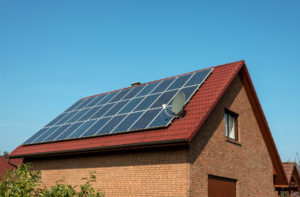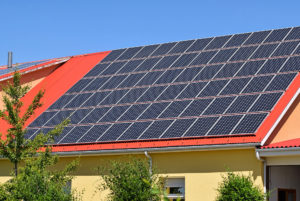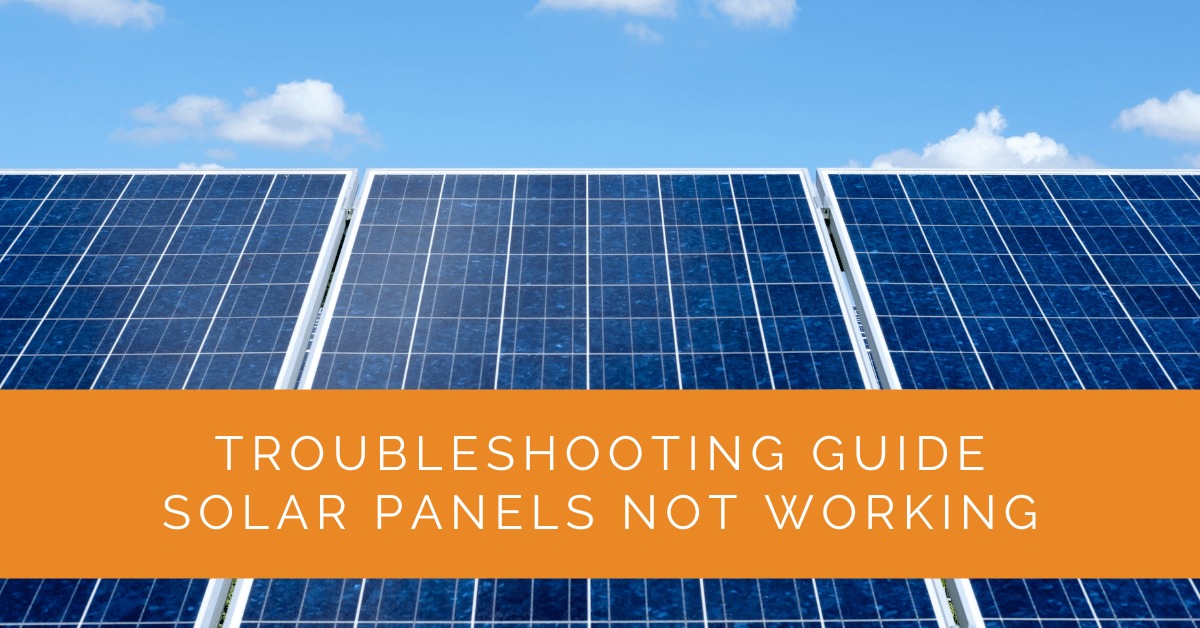Solar panels are an essential solar system component, providing clean and renewable energy. However, it can be frustrating when your solar panels are not working as expected. In this troubleshooting guide, we will explore common problems that can arise with solar panels and provide expert tips to diagnose and resolve them, ensuring your system is working properly and efficiently.
Contents
- 1 Key Takeaways
- 2 Common Solar Panel Issues
- 3 Diagnosing Solar Panel Problems
- 3.1 Step 1: Visual Inspection
- 3.2 Step 2: Monitoring System Performance
- 3.3 Step 3: Testing Voltage Output
- 3.4 Step 4: Checking the Solar Inverter
- 3.5 Step 5: Evaluating Electrical Connections
- 3.6 Step 6: Assessing System Wiring
- 3.7 Step 7: Inspecting Breakers and Fuses
- 3.8 Step 8: Analyzing Data from Solar Meters
- 4 Troubleshooting Specific Solar Panel Issues
- 5 When to Seek Professional Help
- 6 Case Study: Diagnosing and Resolving Solar Panel Performance Issues
- 7 Expert Insights From Our Solar Panel Installers About Troubleshooting Solar Panels
- 8 Experience Solar Excellence with Us!
- 9 Conclusion
Key Takeaways
- Insufficient power generation can result from shading, dirt, a faulty solar inverter, or improper system sizing.
- Low voltage output may be caused by wiring issues, a malfunctioning inverter, or damaged solar cells.
- Physical damage, shading, wiring problems, and obstructions can all impact solar panel performance, but thorough diagnosis and appropriate solutions can address these issues effectively.
Common Solar Panel Issues
To effectively troubleshoot solar panel problems, it is crucial to understand the components of a solar system and identify potential issues. Here are some common problems that can occur with solar panels, along with detailed explanations of each:
1. Insufficient Power Generation
One of the most common issues with solar panels is insufficient power generation. This problem can arise due to various factors. Shading is a primary culprit, where trees, nearby buildings, or other obstructions cast shadows on the panels, reducing the amount of sunlight they receive. Dirt, debris, or bird droppings accumulating on the surface of the panels can also hinder sunlight absorption, resulting in reduced power output. Another potential cause of insufficient power generation is a faulty solar inverter, which converts the panels’ direct current (DC) generated into usable alternating current (AC). Additionally, inadequate system sizing or incorrect panel orientation can impact power generation. Properly diagnosing and addressing these issues is essential for optimizing solar system performance.
2. Low Voltage Output
Low voltage output from solar panels can indicate various problems within the system. It may stem from wiring or connection issues, where loose or damaged wires disrupt the flow of electricity. In some cases, a malfunctioning solar inverter can cause low voltage output. Another possibility is damaged solar cells, which can occur due to manufacturing defects, extreme weather conditions, or physical impact. Monitoring the voltage output of your PV system is crucial to identify this problem early on. By understanding the factors contributing to low voltage output, you can take appropriate steps to resolve the issue and restore optimal performance.
3. Physical Damage or Wear
Solar panels are exposed to the elements year-round, making them susceptible to physical damage or wear over time. This includes potential damage from extreme weather events, such as hailstorms or heavy snowfall, and general wear and tear from prolonged exposure to sunlight. Physical damage can manifest in cracked or broken glass, delamination (layers separating), or corrosion. These issues not only compromise the structural integrity of the panels but also affect their overall efficiency and performance. Regular visual inspections are crucial to identify any signs of physical damage or wear, allowing for timely repairs or replacements to maintain the longevity and effectiveness of the solar panels.
4. Shading or Obstructions
Shading is a significant concern when it comes to solar panel performance. Even partial shading on a small portion of a solar panel can significantly reduce energy production. Shading can result from nearby trees, buildings, or other structures that cast shadows on the panels at certain times of the day. Additionally, objects such as chimneys, antennas, or nearby installations can obstruct the panels’ exposure to sunlight. It is essential to assess the positioning of your panels and identify any potential sources of shading or obstructions. By addressing these issues, such as through strategic panel placement, tree trimming, or obstruction removal, you can maximize the efficiency and output of your solar system.

Diagnosing Solar Panel Problems
To effectively troubleshoot solar panel problems, a systematic approach to diagnosis is necessary. By following these steps, you can identify the root causes of issues and take appropriate actions:
Step 1: Visual Inspection
Begin by conducting a thorough visual inspection of your solar panels. Look for signs of physical damage, such as cracks, chips, or discoloration on the glass surface. Inspect the frames, mounting brackets, and sealants for wear, corrosion, or loose connections. Additionally, check for dirt, debris, or bird droppings that may obstruct sunlight absorption. Cleaning the panels with a soft brush and soapy water can help restore their efficiency if dirt or debris is present.
Step 2: Monitoring System Performance
Regularly monitor your solar system’s performance by comparing the actual power output to the expected values. Keep track of daily, weekly, and monthly energy production to identify any significant deviations. Analyze the data provided by monitoring systems or online portals to detect any unusual patterns or sudden drops in performance. This information can provide valuable insights into the health and functionality of your solar panels.
Step 3: Testing Voltage Output
Measure the voltage output of your solar panels using a multimeter. Compare the readings to the expected values provided by the manufacturer. A significant deviation from the expected voltage can indicate potential issues within the system, such as wiring problems, damaged cells, or inverter malfunctions. Conducting these tests regularly allows you to identify voltage-related problems promptly and take appropriate measures to address them.
Step 4: Checking the Solar Inverter
The solar inverter plays a crucial role in the operation of a solar system. It converts the DC power generated by the panels into AC power for your home or business. Check the inverter for any error messages or fault indicators. Resetting the inverter by turning it off and on can sometimes resolve minor issues. However, if the problem persists, it may require professional attention. Inverter problems can significantly impact the overall performance of your solar system, so proper diagnosis and timely repairs are crucial.
Step 5: Evaluating Electrical Connections
Thoroughly inspect all electrical connections associated with your solar system. Ensure that all wiring connections, junction boxes, and connectors are secure and free from damage or corrosion. Loose or damaged connections can disrupt the electricity flow and impact your solar panels’ efficiency. Tighten any loose connections and replace damaged components to ensure proper electrical conductivity.
Step 6: Assessing System Wiring
Review the wiring of your solar system to ensure it complies with industry standards and follows the manufacturer’s guidelines. Check for any signs of damaged or frayed wires that could potentially cause issues. Properly sized and routed wiring is essential for optimal system performance. If significant wiring issues are detected, or you are unfamiliar with electrical systems, it is recommended to consult a professional electrician for assistance.
Step 7: Inspecting Breakers and Fuses
Examine the breakers and fuses associated with your solar system. Ensure they are in the correct position and have not tripped or blown. Faulty breakers or fuses can interrupt the flow of electricity, leading to solar panel problems. A breaker or fuse repeatedly tripping or blowing may indicate an underlying issue that requires professional attention.
Step 8: Analyzing Data from Solar Meters
If your solar system includes solar meters, utilize the data provided by these devices to gain further insights into the performance of your panels. Analyze the data for any unusual trends, fluctuations, or anomalies. Significant deviations from expected patterns can indicate specific problems, such as a sudden drop in energy production or irregular voltage output. Utilize this data to identify and address issues promptly.
By following these systematic steps and thoroughly diagnosing solar panel problems, you can effectively troubleshoot issues and take the necessary actions to restore your solar system’s proper functioning and performance.

Troubleshooting Specific Solar Panel Issues
Let’s delve deeper into troubleshooting specific solar panel issues and explore possible causes and solutions for each problem:
1. Insufficient Power Generation
Cause: Insufficient power generation can occur due to shading from nearby trees or structures, dirt or debris on the panels, a faulty solar inverter, or improper system sizing or panel orientation.
Solution: To address shading issues, consider trimming or removing obstructions that block sunlight from reaching the panels. Regular cleaning of the panels can help remove dirt and debris that hinder sunlight absorption. If the solar inverter is suspected to be faulty, contacting a professional for diagnosis and repair is recommended. Additionally, consulting with a solar professional can help ensure proper system sizing and panel orientation to optimize power generation.
2. Low Voltage Output
Cause: Low voltage output can stem from wiring or connection problems, a malfunctioning solar inverter, or damaged solar cells.
Solution: Thoroughly inspect all wiring and connections for loose or damaged components. Tighten connections and replace faulty wires or connectors as needed. If the solar inverter is the suspected cause, consult a professional for further examination and repair. For damaged solar cells, professional assistance may be required to replace the affected panels or cells.
3. Physical Damage or Wear
Cause: Physical damage or wear can result from various factors, including extreme weather conditions, impacts, or prolonged exposure to sunlight.
Solution: Conduct regular visual inspections to identify signs of physical damage, such as cracks, chips, or discoloration on the glass surface. If damage is detected, contacting a professional installer or manufacturer is advisable for appropriate repairs or panel replacements. Additionally, practicing preventive measures like installing protective covers or using stronger and more durable solar panel materials can help minimize the risk of physical damage.
4. Shading or Obstructions
Cause: Shading or obstructions from nearby structures or objects can limit the amount of sunlight reaching the solar panels, thereby reducing energy production.
Solution: Assess the positioning of your panels and identify any sources of shading or obstructions. Consider adjusting the placement of the panels, trimming trees, or removing objects that cast shadows on the panels. Maximizing the exposure of the panels to direct sunlight will enhance their performance and energy production.
5. Wiring or Connection Issues
Cause: Wiring or connection problems, such as loose or damaged wires, improper termination, or faulty connectors, can disrupt the flow of electricity within the solar system.
Solution: Thoroughly inspect all wiring and connections, paying close attention to loose or damaged components. Secure any loose connections and replace damaged wires or connectors. It is recommended to seek professional assistance if significant wiring issues are detected or if you are uncertain about the electrical system’s complexity.
When to Seek Professional Help
While troubleshooting can often resolve common solar panel issues, there may be situations where professional assistance is necessary. Seek professional help in the following cases:
- Complex electrical issues or unfamiliarity with electrical systems.
- Inverter problems that require specialized knowledge or tools.
- Structural damage or extensive repairs beyond your expertise.
- Safety concerns or if you feel uncomfortable performing troubleshooting tasks.
Remember, safety should always be a priority. If, at any point during the troubleshooting process, you encounter a situation that poses a risk, contact a professional electrician or solar installer.
Case Study: Diagnosing and Resolving Solar Panel Performance Issues
Background
Solar Panels Network USA was contacted by a homeowner experiencing reduced energy production from their solar panel system. The goal was to diagnose the underlying issues and restore the system to its optimal performance.
Project Overview
The homeowner reported a significant drop in energy production despite favorable weather conditions. Our team was tasked with identifying the causes and implementing effective solutions to resolve the performance issues.
Implementation
Step 1: Visual Inspection
Our team conducted a thorough visual inspection of the solar panels, checking for any signs of physical damage, such as cracks, chips, or discoloration on the glass surface. We also inspected the frames, mounting brackets, and sealants for wear, corrosion, or loose connections.
Step 2: Monitoring System Performance
We reviewed the system’s performance data, comparing the actual power output to the expected values. This involved analyzing daily, weekly, and monthly energy production to identify any significant deviations. The data revealed a consistent pattern of reduced energy output.
Step 3: Testing Voltage Output
Using a multimeter, we measured the voltage output of the solar panels and compared the readings to the manufacturer’s expected values. The results showed a significant deviation, indicating potential issues within the system, such as wiring problems or damaged cells.
Step 4: Checking the Solar Inverter
We inspected the solar inverter for error messages or fault indicators. Although resetting the inverter temporarily resolved some issues, the problem persisted, suggesting a deeper issue with the inverter.
Step 5: Evaluating Electrical Connections
We thoroughly inspected all electrical connections associated with the solar system. This included checking wiring connections, junction boxes, and connectors for any loose or damaged components. Several loose connections were identified and promptly tightened.
Step 6: Assessing System Wiring
We reviewed the wiring of the solar system to ensure it complied with industry standards and the manufacturer’s guidelines. Damaged and frayed wires were detected and replaced, improving the system’s overall electrical conductivity.
Step 7: Inspecting Breakers and Fuses
We examined the breakers and fuses associated with the solar system to ensure they were in the correct position and had not tripped or blown. A faulty breaker was identified and replaced, restoring the flow of electricity.
Step 8: Analyzing Data from Solar Meters
We utilized data from the solar meters to gain further insights into the performance of the panels. The data revealed irregularities that aligned with the physical and electrical issues we had identified.
Results
After implementing these diagnostic and corrective measures, the solar panel system’s performance improved significantly. The homeowner reported a marked increase in energy production, and the system returned to its optimal performance level. The combination of visual inspections, performance monitoring, and addressing wiring and inverter issues proved effective in resolving the problems.
Summary
This case study underscores the importance of a systematic approach to diagnosing and resolving solar panel performance issues. By conducting thorough inspections, monitoring system performance, and addressing identified problems, Solar Panels Network USA successfully restored the system’s efficiency. Regular maintenance and timely interventions are crucial to ensuring the long-term performance and reliability of solar panel systems.
Expert Insights From Our Solar Panel Installers About Troubleshooting Solar Panels
Regular monitoring of your solar system’s performance can help identify issues early on. Analyzing daily and monthly energy production can highlight deviations and allow for timely intervention.
Senior Solar Technician
Physical damage to solar panels, such as cracks or corrosion, can significantly impact efficiency. Regular visual inspections and prompt repairs are essential to maintaining optimal performance.
Lead Installation Engineer
Proper wiring and secure electrical connections are crucial for the efficient operation of solar panels. Loose or damaged wires can cause low voltage output and disrupt the entire system’s performance.
Solar Maintenance Specialist
Experience Solar Excellence with Us!
Trust in Solar Panels Network USA, where our seasoned experts deliver top-quality solar solutions for homes and businesses nationwide. With a legacy of countless successful installations and a commitment to sustainable energy, we’re your reliable partner in the solar journey. Ready for a brighter, eco-friendly future? Call us now at (855) 427-0058 and harness the power of the sun!
Conclusion
Troubleshooting solar panel problems is an essential step in maintaining the optimal performance of your solar system. By understanding common issues, performing thorough inspections, and following the diagnostic steps outlined in this guide, you can identify and resolve problems with your solar panels. Regular maintenance, timely repairs, and professional assistance, when needed, will ensure that your solar system operates efficiently, providing clean and renewable energy for years to come.
About the Author
Solar Panels Network USA stands at the forefront of solar energy solutions, driven by a team of seasoned solar engineers and energy consultants. With over decades of experience in delivering high-quality solar installations and maintenance, we are committed to promoting sustainable energy through customer-centric, tailored solutions. Our articles reflect this commitment, crafted collaboratively by experts to provide accurate, up-to-date insights into solar technology, ensuring our readers are well-informed and empowered in their solar energy decisions.

